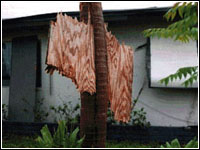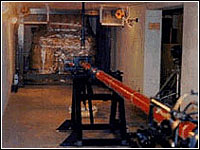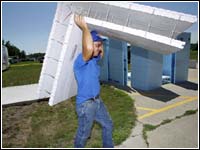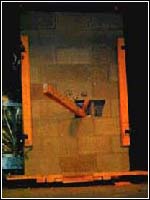 |
 |
 |
 |
 |
Tornado Safe Rooms
![]() tornadoes can happen in almost every state of the U.S. There are some
states that are at higher risk, especially states like Kansas and Oklahoma
that are in "Tornado Alley." (To see your risk go to the tornado
map.)
tornadoes can happen in almost every state of the U.S. There are some
states that are at higher risk, especially states like Kansas and Oklahoma
that are in "Tornado Alley." (To see your risk go to the tornado
map.)
FEMA is urging people who live in tornado-prone areas to make sure they have a tornado-safe place to go during a tornado. A basement is considered a good, safe place to go during a tornado. But what if your house doesn't have a basement? What should you do? FEMA says you can build a tornado "safe room" right in your house.
 |
 |
 |
| Palm tree pierced by plywood missle. Hurricane Andrew | Missle (debris) launcher, Wind Engineering Research Center (WERC), Texas Tech University. | Photographs of Safe Room Construction |
Tornadoes are very destructive and can be very deadly. It's important that people have a safe place to go during a tornado. A specially built safe room can save lives.
![]() built safe rooms can provide protection against winds of up to 250 miles
per hour and against flying objects travelling as fast as 100 miles per
hour. The plans for the safe rooms were developed along with the Wind
Engineering Research Center of Texas Tech University in Lubbock, Texas.
built safe rooms can provide protection against winds of up to 250 miles
per hour and against flying objects travelling as fast as 100 miles per
hour. The plans for the safe rooms were developed along with the Wind
Engineering Research Center of Texas Tech University in Lubbock, Texas.
The idea behind safe rooms is that they are built inside but separate from the main house. The walls and ceilings are extra thick and strong so that the safe room remains standing and intact even if the rest of the house is destroyed by high winds and flying objects.
The extreme winds caused by tornadoes are very destructive. The way the winds change direction around houses and other buildings can put even more pressure on a house. The connections between the walls and the roof can fail and windows can be pushed in. Another problem is the winds produce flying objects that are going very fast. They are going so fast that they can penetrate windows, walls, or a roof.
![]() example, in a 250-mile-per-hour wind an object such as a 2" x 4"
wood stud weighing 15 pounds can have a speed of 100 mph and enough force
to penetrate most common building materials used in houses today.
example, in a 250-mile-per-hour wind an object such as a 2" x 4"
wood stud weighing 15 pounds can have a speed of 100 mph and enough force
to penetrate most common building materials used in houses today.
That's why a tornado safe room is so important. A tornado safe room should be built inside a house where it's easy to get to. It must be anchored to the house foundation to resist overturning and uplift. The connections between all parts of the shelter must be very strong and the walls, roof and door must be strong enough not to be penetrated by flying objects.
Tornadoes should be taken seriously. Talk to your parents about your tornado risk and tell them about safe rooms.
 |
| 2" x 4" wood stud launched at 100 mph pierces unreinforced masonry wall, WERC, Texas Tech University. |
